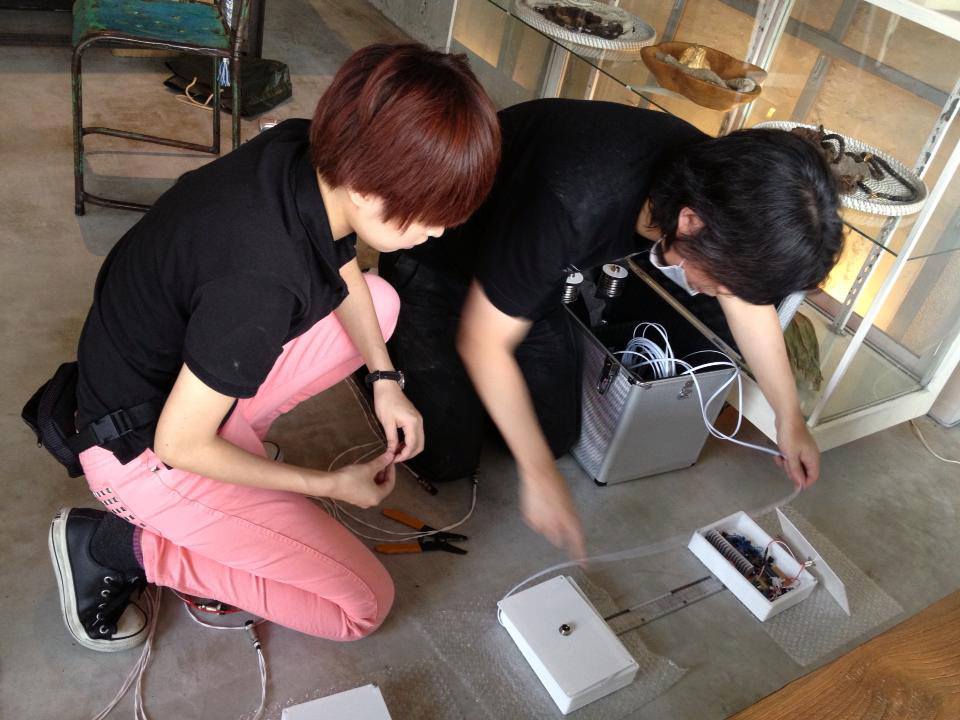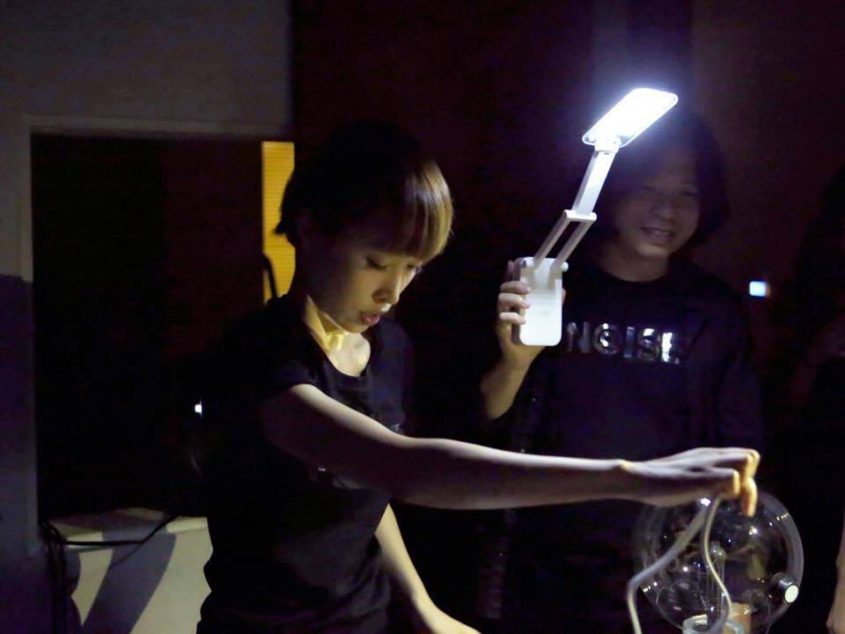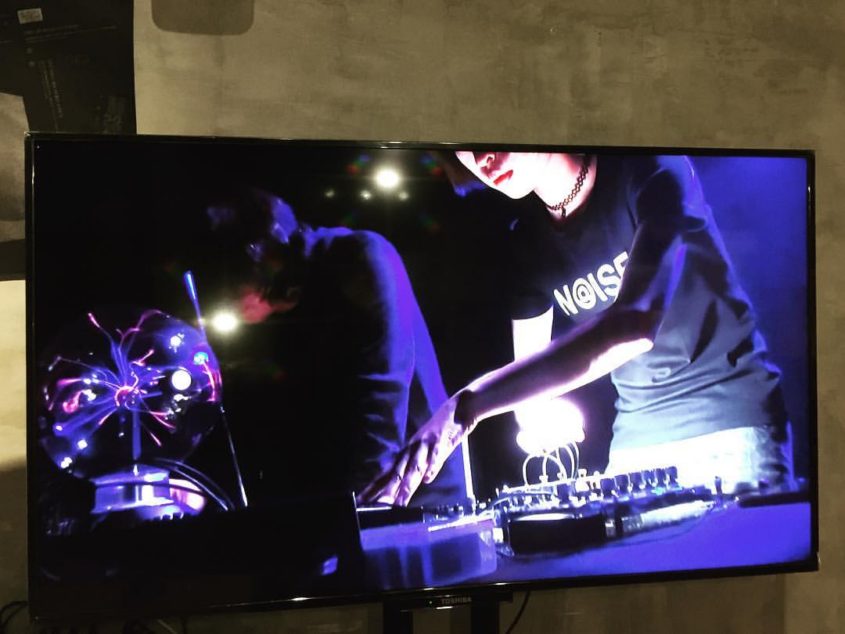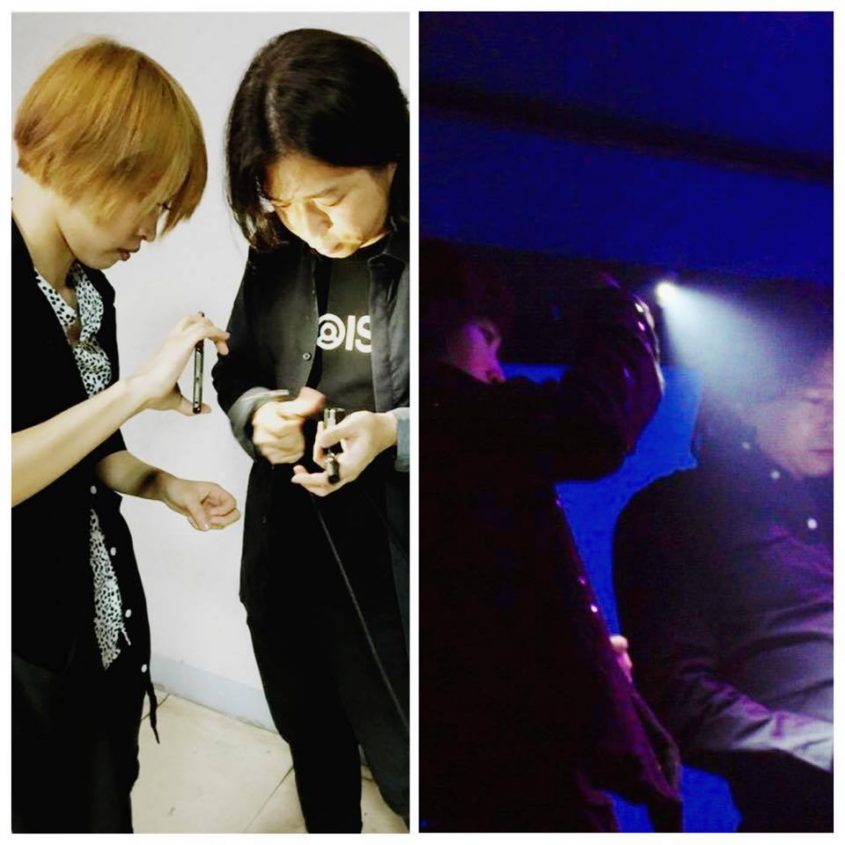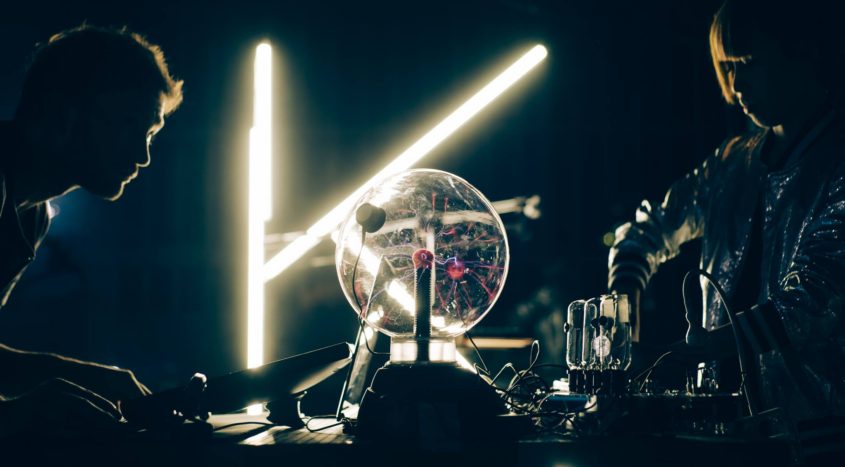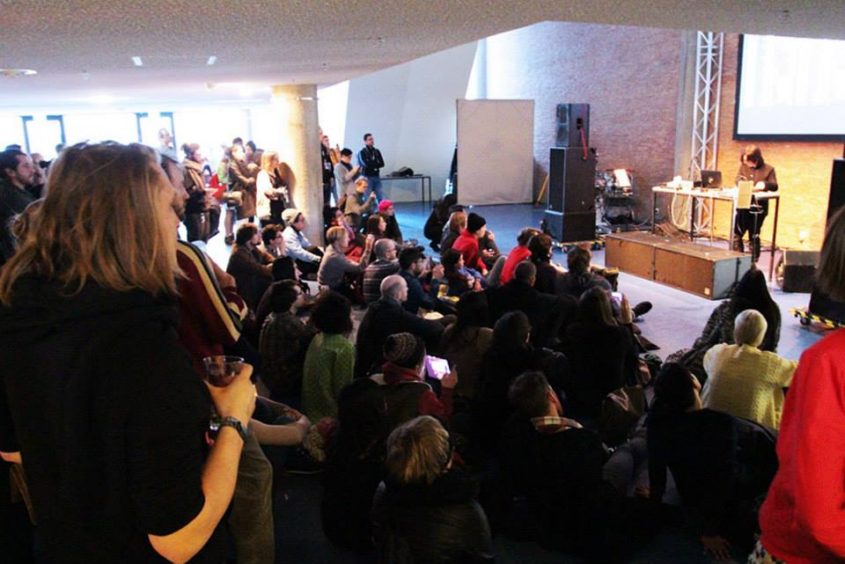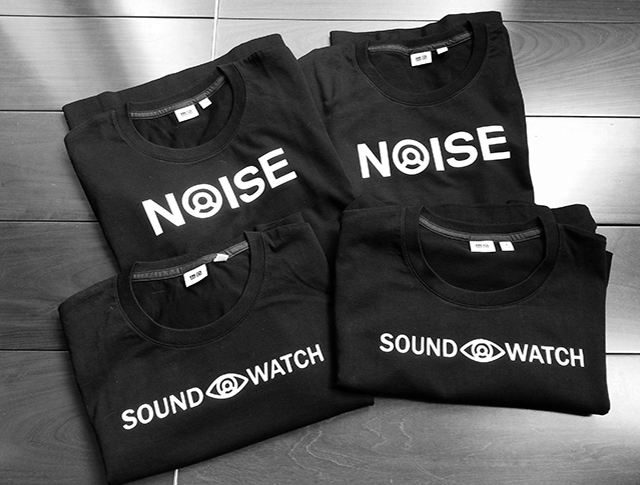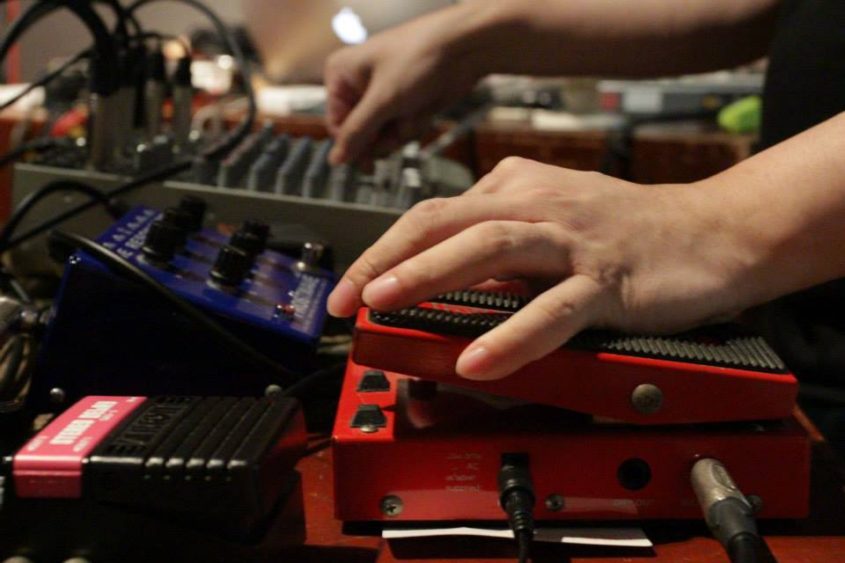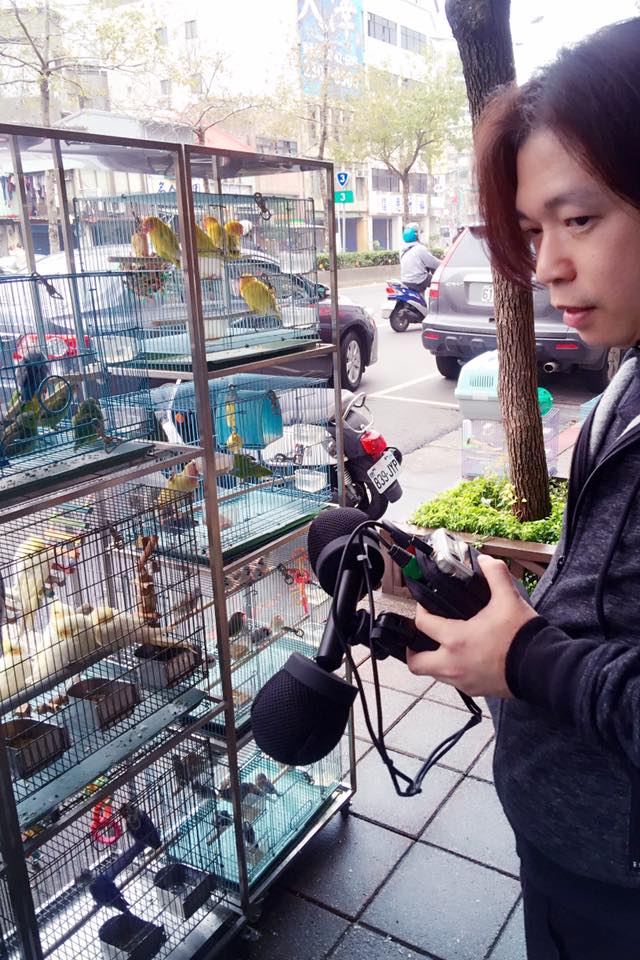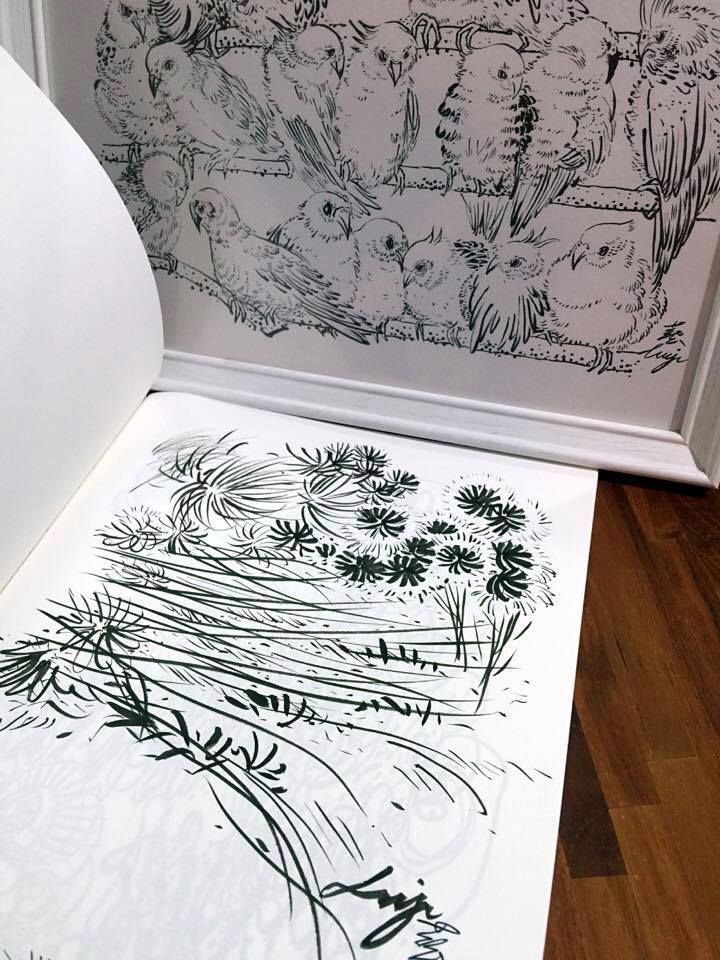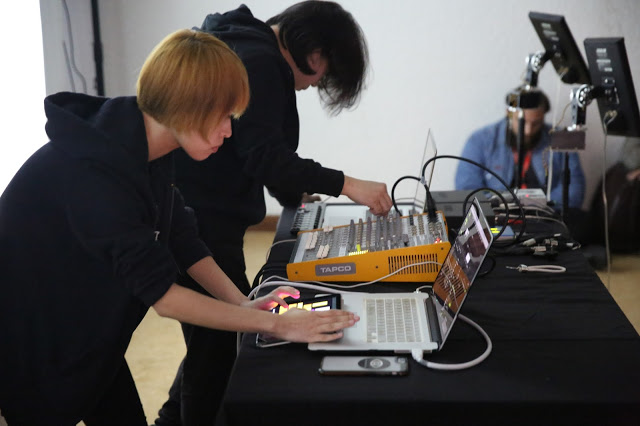 Photo by DAC in B!as 2015: Taiwan-Belgium Sound Art Exchange Project:Hyper Transmission – Fujui Wang Live Performance,2015
Photo by DAC in B!as 2015: Taiwan-Belgium Sound Art Exchange Project:Hyper Transmission – Fujui Wang Live Performance,2015
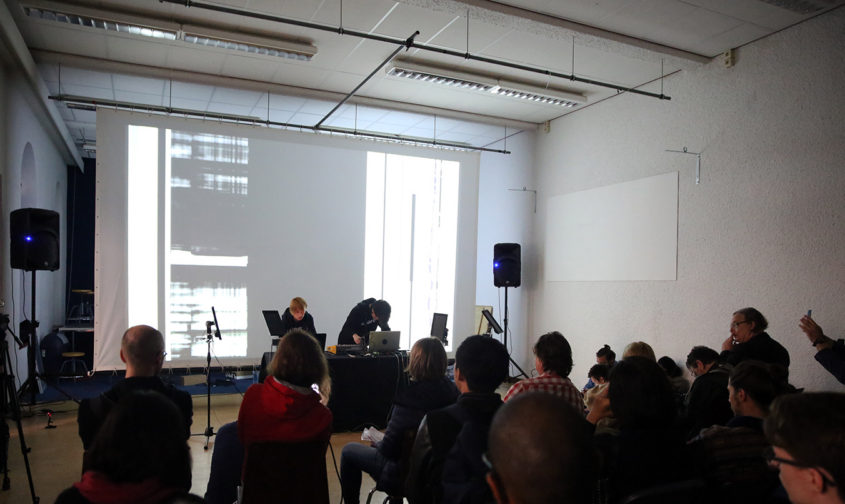 Photo by DAC in B!as 2015: Taiwan-Belgium Sound Art Exchange Project:Hyper Transmission – Fujui Wang Live Performance,2015 『台異響2015─台比聲音藝術交流計畫』,分別由台北數位藝術中心,以及比利時「跨文化數位與聲音文化中心」(Transcultures, Center of digital and audio cultures)主辦,推介當地最具代表性之聲音藝術家至蒙斯、台北展演。
Photo by DAC in B!as 2015: Taiwan-Belgium Sound Art Exchange Project:Hyper Transmission – Fujui Wang Live Performance,2015 『台異響2015─台比聲音藝術交流計畫』,分別由台北數位藝術中心,以及比利時「跨文化數位與聲音文化中心」(Transcultures, Center of digital and audio cultures)主辦,推介當地最具代表性之聲音藝術家至蒙斯、台北展演。
How does Lu Yi start to collaborate with Fujui Wang?
為何會有「Soundwatch Studio 響相工作室」?兩人如何開始合作?
Lu Yi:
At the time, I wanted to take a path of life beyond one could imagine. Simply speaking, I didn’t want to be a stray teacher anymore and wanted to prove to my family that I could change profession. Meanwhile, I met artist Fujui Wang by chance; he was looking for an administrative assistant to help him to arrange his trips. I wasn’t sure whether if I was really capable of entering the field of art or that of sound art. In my college years, I was trained as a primary school teacher in fine arts which were more about the craft. My idea about art was quite limited. Moreover, I wasn’t sure whether if I could change my position as a stray teacher. At the time, the only solution I’ve got was to work as a freelancer while working for Fujui. So I always had a part-time job in a private art class for children, a small design company, in MOCA Taipei or worked as a freelance arts journalist. I sought any job I could found. It was also through journalism that I had chances to interview artists like Shen Sheng-Po, Chang Geng-Hau, Niu Chun-Chiang, among others. As for MOCA Taipei, it was when Fujui prepared a solo show, “Hyper Transmission” in MOCA Studio that I saw the museum’s job ad to hire part-time employees for public service. Considering this a chance to learn art closely, I didn’t hesitate to apply for the job. So I worked four days a week for Fujui; on the other three days, I worked for MOCA with a team of rather young people.
盧藝:
這要倒回到自己當時2011年從舊金山回台後,想走一條想像之外的人生路,簡單來說就是不想再當流浪教師,想跟家人證明有能力轉行,也剛好遇到聲音藝術家王福瑞正在找一名行政助手,幫忙處理他出差的個人事務,當時也不是很清楚是否自己真有能力,可以走入藝術或聲藝這領域裡,自身擁有的能力也就只有自學的視覺設計,與大學教育的背景,對藝術的想法很有限,對所謂新媒體藝術也只停留在欣賞或空想的階段,更不確定自己是否真的能夠脫離流浪教師的行列,那時想到唯一的方法就是,以接案的方式一邊跟著福瑞,所以一直都還有另一份兼職工作同時進行中,在兒童繪畫教室、小設計公司、藝文特約記者和台北當代館打工….有看到什麼機會就去,那時候就藉著記者的機會採訪過沈聖博、張耿豪、牛俊強…等藝術家;台北當代藝術館的工作是因為福瑞要在MOCA Studio《超傳波Hyper Transmission》個展,看到官網徵公眾服務工讀生,想說這也是份近距離學習藝術的機會,又只是一週去三天,也沒多想就去應徵了,就這樣一週四天替福瑞工作,另外三天是在當代館,跟著一群年紀超青春的小朋友工作。(笑)
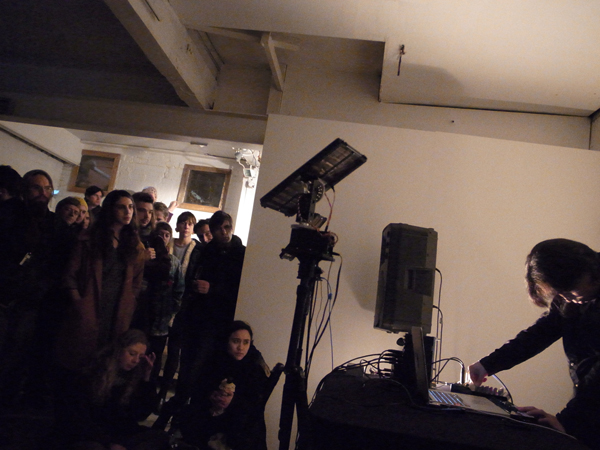 Photo by Soundwatch in the Russian Frost Farmers Gallery,Wellington,NZ
Photo by Soundwatch in the Russian Frost Farmers Gallery,Wellington,NZ
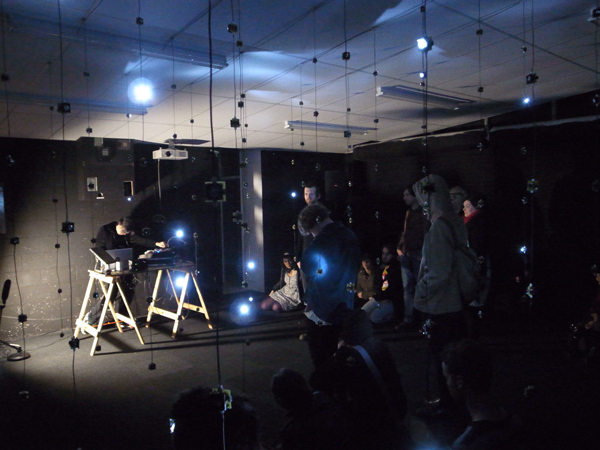 Photo by White Fungus in the Physics Room Gallery,Christchurch,NZ
Photo by White Fungus in the Physics Room Gallery,Christchurch,NZ
Lu Yi:
Between 2012 and 2013, an international magazine on avant-garde art, White Fungus invited our studio to tour abroad and hold several exhibitions and performances. Besides, we joined “Depopulate 01”, “Depopulate 02”, “Depopulate 03” and “Depopulate 05”, a series of events held in Taipei for the magazine’s launch. Afterwards, I gradually felt that the situation allowed me to get closer to art and that I could begin to assist in controlling the real-time images in the performance of “Hyper Transmission”. I wanted to let Fujui concentrate more on his sound performance. Moreover, I thought the best way to learn was doing it yourself(i.e. being on the stage together). The psyche of a co-performer on the stage differs from that of an audience or someone assisting in filming. When you’re on the stage, you feel a real tension. You prepare more in advance and get more feedback afterwards.
The first time I went on stage with Fujui was in our performance in “Onsite” in Taipei in 2014; I was in charge of the visual part. And it was in April 2015 in England that I made my first personal sound performance. Both performances were important to me and the studio in the sense that people began to identify my role differently. Although the two of us have started to make projects under the name “Soundwatch Studio” in 2011, it was after these two performances that we really began to gain attention. More and more, Fujui would introduce me as his working partner, not merely an assistant. As for job division, roughly speaking, Fujui is more oriented towards technology/development/production whereas I’m more oriented towards writing/administration/workshops/documentation/media promotion. Our relation is not so much about a master and a disciple or a senior and a subordinate. Rather, we’ve developed ways of mutual coordination from many years of collaboration.
盧藝:
在2012到2013年間,國際前衛雜誌《白木耳White Fungus》邀請工作室巡迴海外多場展演,以及陸續在台北的雜誌發行活動《Depopulate 01》、《Depopulate 02》、《Depopulate 03》和《Depopulate 05》演出後,漸漸地整個狀態讓我有更接近藝術的機會,開始可以幫忙控制《超傳波 Hyper Transmission》表演中的即時影像,除了可以讓福瑞更專心在聲音表演上,做更多分擔外,我的想法是:學習最好的方式就是去動手做(一起上舞台),這和當個聽眾或幫忙攝影的內心狀態是不同的,站在台上會感覺到一份真實的緊張感,事前準備會更認真,也會更有回饋。
我和福瑞的第一次一起站上舞台,是2014年台北《混種Onsite》表演,以及我自己個人2015年在英國《射殺鋼琴師-台北90-95噪音現場》表演。這兩場表演對我自己和工作室很重要,因為外界開始對自己的角色有所轉變,雖然2011年兩人就以「響相工作室Soundwatch Studio」執行一些案子,真的開始得到一些外界關注是在這兩場表演之後,漸漸地福瑞介紹我時也不只是助手,更會說是事業上夥伴(partner),而工作室內部分工,大致上福瑞偏向技術/研發/製作,我偏向文字/行政/工作坊/記錄/媒體宣傳,不只是師徒和上下屬關係,兩人更有長達多年工作上磨合來的默契。
 Photo by Watan in《拆除前夕-論壇與聲音表演》陳界仁策劃,2012
Photo by Watan in《拆除前夕-論壇與聲音表演》陳界仁策劃,2012
What Fujui thinks about Lu Yi?
福瑞對盧藝的看法?
Fujui:
The name of my website, “Soundwatch” includes “watch”; I attempt to imply some contrast. I hope they experience sound through another sense rather than the conventional understanding of sound through listening/hearing. It’s the same for noise; it requires a different angle of listening and definition. After Yi Lu joined the studio, I was allowed to concentrate more on my sound art since she shared some of my work. It’s also thanks to her consistent help and accumulated experience, we finally came to hold a show of us under the name of Soundwatch studio. The show in the DigiLog sound lab differs from the context of my own sound art context in that we came to apply a kind of sense of object, of design and ideas that were more accessible to the public.
Lu Yi has a kind of naivety. Her personality implies eagerness and obstinacy. Maybe it’s because she wanted to change her family’s expectation on her of becoming a primary school teacher, she was always impatient to see the result. In recent years, she has tried many things. In addition to administration affairs I assigned her at the start, she also ventured into fanpage management, visual documentation of performances, text documentation of interviews and filing curators’ emails. Besides, she also assisted in producing works and took n several educational workshops. The more well-known projects she took part in are the education project in rural areas by the Shiner Education Foundation and visual and sound performances in collaboration with French designer Sébastien Labrunie.
福瑞:
我自己的個人網站名字Soundwatch中用字watch就希望有反差的意思,讓大家不要以原有『聽』(listen/hear) 來解讀去理解聲音這件事,而是運用另一種感官去體驗,噪音也是一樣,需要用另一種角度去聆聽和定義,工作室加上盧藝後,她可以幫忙分擔一些,讓我更可以專心在聲音創作上,也因為有她一直以來的幫忙和經驗累積,我們這次終於有了以響相工作室名義兩人的展,有別我原來聲音藝術的創作脈絡,改用一種物件感、設計、親民的想法概念在《DigiLog聲響實驗室》呈現。
盧藝有股傻勁,個性上很好強也很固執,工作上有時候會想太多而在原地打轉,可能也是她想要改觀家族對她原有從事國小老師的期待,所以她老是很急著想要看到成果,這幾年她做了許多嘗試,除了原有的行政事務外,嘗試了粉絲專頁經營、表演攝影記錄、文字訪談記錄、策展人來信的資料整理、輔助作品製作等等,也接了許多教學工作坊,現在大家比較知道是她《立賢基金會The Shiner Education Foundation》的偏鄉教育計畫以及與法國設計師Sébastien Labrunie的視覺與聲音合作表演。
What Lu Yi thinks about Fujui?
盧藝對福瑞的看法?
Lu Yi:
Fujui has a lot of confidence in me. He would directly authorize me to do certain jobs. Basically our opinions are quite similar and he also often lets me talk about my opinions. I would approach discussions from the angle of an onlooker or of a museum rather than that of an artist. After all, during the two years I worked for MOCA Taipei, I’ve observed each exhibition and how visitors looked at artworks. I also learned a lot about how to comment on art. Sometimes I’d have some whimsical ideas and Fujui always says, “You’ll only know after you’ve tried” or “Do it right away if you feel it’s right and don’t think too much”. I remember how I printed the QR code of the studio’s website link on the back of my cell phone and asked people I met in openings or performances to scan that code so we got more likes on our fan page. Usually, people find it hard to refuse when they’re asked vis-a-vis(laugh). I also re-designed the studio’s logo and printed it on stickers to give to people, or put the logo on T-shirts Fujui wore on the stage, etc. In short, Fujui generously lets me try anything I could, which certainly gradually involved performing on the stage and sound art-making. Since I began to collaborate with Sébastien, Fujui has attended almost all our performances.
Having worked with Fujui for so many years, I know he clings to perfection and his persistence in continuing on the path of sound art. This moved me and encouraged me to run the studio with him. It’s a resolution to go through ups and downs together and to explore a kind of individuality of life. We should work hard, cherish time, confront the society’s doubt and consistently challenge our internal and external limits. The unknown and the feeling of adventure in taking this path were very attractive to me.
盧藝:
福瑞對我很信任,把一些工作直接授權。我不需要寫太多細節的email,或是要花很多時間與福瑞溝通,基本上兩人對很多事物上看法滿一致,福瑞也常常問我意見,我會把藝術家以外的觀點(例如以旁觀者或美術館的角度)切入討論,畢竟先前在《當代館Moca Taipei》有兩年時間觀察每一檔展覽,在展間來回看著觀眾怎麼欣賞藝術品,怎麼評論作品,也滿有心得的。另外福瑞也很鼓勵我創作,不只是創作聲音,也很支持我做很多不同的嘗試,有時候我突然會有些怪想法,福瑞都會說那去試才知道,或你覺得對就趕快去做,不要想那麼多,做了遇到問題再來解決。我記得為了要衝工作室FB專頁的按讚人數,就把網址印成QR Code貼在手機背面,每一次在開幕或表演現場認識新朋友,我就把手機轉過來請他們用手機掃描按讚,通常當面要求對方都很難拒絕(笑),後來也重新設計印製工作室LOGO貼紙發送,或幫福瑞表演黑衣印上親手製作的LOGO…之類的,總之我能做的福瑞都很大方讓我去嘗試,當然後來漸漸也開始站上舞台表演和創作聲音,與Sébastien一起合作後幾乎每一次表演,福瑞都會到場支持。
有一部日本紀錄片《拉麵之神 The GOD of Ramen》,裡面主角山岸一雄被稱之為神,本身的固執堅持的能量是要很巨大的,不斷地撐著心中想要完成的事,在起起伏伏的創作路上往前進,也從不藏私去計較自身擁有的功夫,不吝嗇分享給學藝的學徒,那狀態就會擁有一種純然氣場散發出來,讓人感受到一股吸引力與爆發力,而我幫福瑞工作這麼多年,知道他這份執善的內心和不斷堅持創作聲藝路,感動了我,也激勵了我一起與他共同經營工作室,一同進退的決心,探索一種生命獨特性,要拼命工作,要珍惜時間,要面對社會對自身的質疑,要不斷挑戰自己內外的極限,走在這條路上的那種未知感與冒險感,很吸引我。
Some interesting projects by the Soundwatch Studio.
相關有趣的案子?
Lu Yi:
In 2015, Fujui was invited to record real sounds from Taipei for a project titled “One City One Sound”. So Fujui and I went to several locations to collect sounds, including the area with many bird shops on Heping W. Rd., the basement of the Taipei Fine Arts Museum, the Da-an Forest Park and the metro station there, etc. Fujui used a Superlux S502 ORTF microphone and a Sound Devices 722 recorder. The piece involves the following text, “I was surprised to hear an intense burst of birds’ sing during a ride in the city. It’s rare to have such an experience in a city. Being caged, birds from nature become quite artificial. They also reflect the urban life with dense population…”.
The project requires accompanying visual elements for the sounds. I used to sketch casually. So I spontaneously asked to do the visual part. When I was about to draw, I thought birds in the real world are already caged, just like people in the city. If I draw cages, it would be visually uncomfortable. I also didn’t want to repeat the feeling of being restrained. I finished the drawing and sent it out. The project manager was quite surprised by the visual representation. I’ve been complacent secretly for some time. I felt it’s a chance where I could make a different interpretation to make the studio’s work better. I also felt my role is just the watch in Soundwatch!
盧藝:
除了大家比較知道的國際和台灣的展演外,在2015年因為《TANC聽得見的城市 | 一聲一城》計劃,邀請福瑞錄製台北實地的聲音。兩人便在和平西路的鳥街、北美館的地下室、大安森林公園和捷運站…等處進行聲音採集,福瑞使用Superlux S502 ORTF麥克風和Sound Devices 722錄音機錄音,並搭配一段文章:『一次坐車經過聽到一陣密集的鳥鳴而感到驚奇,很難在都市有此聆聽經驗…鳥兒密集關在鳥籠中,形成非常人工的自然,像似電子音樂般,也好似人口密集的都市生活…』。
計畫中需要為聲音畫出一些輔助的視覺,這也是我以前就會亂塗亂畫的,聽到計畫中有需要視覺的部分,就主動要求這塊,原本要如實地畫出籠中鳥,但動筆時想到現實中鳥就像都市人都已經被關在籠子裡,如果再畫出鳥籠,除了視覺上不舒服外,內心真的不想再一次有束縛感。完成後寄出給對方後,福瑞說對方回信很驚訝視覺呈現的部份,這件事讓我暗暗高興了好一陣子,自己正好可以運用另一種詮釋方式來為工作室加分,也覺得自己的角色就是Soundwatch裡的watch!
